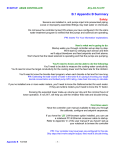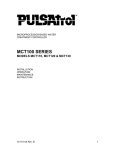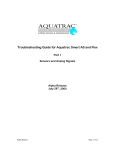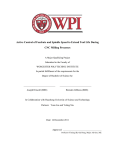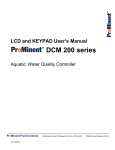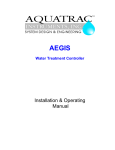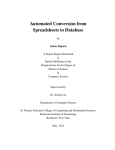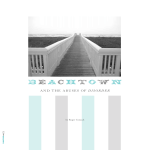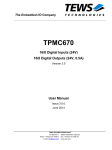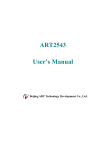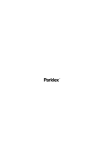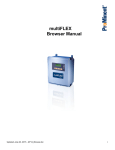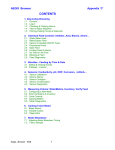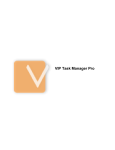Download User Manual: Aegis Modbus
Transcript
AEGIS_Modbus Ethernet TCP CONTENTS 1. Overview 2. Address Contents 2.1 Current Values of Sensors, Meters, Contact Sets 2.2 Current Values of ON/OFF Relays and Frequency Control Outputs 2.3 Current State of Sensors, Meters, Contact Sets 2.4 Current State of ON/OFF Relays and Frequency Control Outputs 2.5 Control State of ON/OFF Relays and Frequency Control Outputs 3. Aegis_Modbus Client 4. Socket & Packet Structures 4.1 TCP Packets 4.2 Floating Point & Integer-to-Bit Conversion Application Note Aegis_modbus 1. Overview Ethernet Modbus TCP implementation of a Modbus slave @ Modbus address 1, on the default Modbus port number 502 using the static IP address user set for the Aegis controller, defaulted to 10.10.6.106. Supports Modbus command 0x03, ‘Read Holding Registers’, where each register returns a 16 bit, 2 byte integer, in ‘big endian’ format, most significant byte first. The address space for command 0x03, ‘Read Holding Registers’ defines 4 byte floating point return values so each controller value must be read as 2 sequential addresses and converted by the client application to a IEEE 754 32 bit floating point ( IEC1131, Intel single precision real ) ,1 bit sign, 8 bit exponent and 23 bit value/mantissa. The 4 byte, 2 register floating point number is sent ‘big endian’. Details of the Modbus TCP-IP message header ( www.modbus.org/specs.php ) and the binary-tofloat conversion and error handling are typically handled by the Modbus client for your EMS/DCS HMI. The implementation returns either the requested holding register values using the Modbus Ethernet message format or one of the following exception codes: Exception 0x01 0x02 0x06 Name Illegal Function Illegal Data Address Busy Cause Command not supported by controller Start or Span address out of range Controller busy with another request. User Configured: Disabled I/O, Sensor Driver Cards, Digital Inputs Aegis controller users may elect to disable unused I/O to remove clutter from the controller LCD display and to simplify using the browser HMI. To prevent exceptions due to reading disabled I/O, each disabled I/O returns a defined, default value out of the range of possible values for enabled I/O. Zero is a possible value for enabled I/O. Aegis controllers may have a variety of sensor driver cards installed in the C-D and E-F driver slots. Some controllers may use these slots for pH & ORP, others for corrosion rate, others for 4-20mA outputs …. The Modbus response to reading these values is in the units of the driver card; ORP in mV, corrosion rate in mpy, temperature in C or F, conductivity is uS….. The 12 Aegis digital inputs ‘O’ to ‘Z’ may be user configured as contact set inputs or volume measurement inputs. Contact sets return the time closed in seconds and volume inputs return the volume from midnight. Aegis_modbus.doc 12/12/08 Page: 2 Application Note Aegis_modbus 2. Address Contents Address spans are separated by function. Address Span 100 to 151 Total # of 16 bit Registers 52 Format Usage Float Input Values Sensor, Volume and Contact set current values. Read to update current state displays. Output Values Relay ON times and Frequency control rates. Read to update current state displays. 200 to 217 18 Float 300 to 325 26 2 Byte UInt16 Input State-Status: Enabled, Alarmed 4-20mA Output Cards: Interlocked, Loop Open & Manual Mode 400 to 408 9 2 Byte UInt16 Output State-Status: Enabled, Alarmed, Events Exist 500 to 508 9 2 Byte UInt16 Output Control State: Configuration & Operational state information Aegis_modbus.doc 12/12/08 Page: 3 Application Note Aegis_modbus 2.1 Current Values of Sensors, Meters, Contact Sets Addresses 100 to 151 inclusive, Request 52 registers starting @ 100 to get all current values Address / IO 100 / A 102 / B 104 / C 106 / D 108 / E 110 / F 112 / G 114 / H 116 / I 118 / J 120 / K 122 / L 124 / M 126 / N 128 / O 130 / P 132 / Q 134 / R 136 / S 138 / T 140 / U 142 / V 144/ W 146 / X 148 / Y 150 / Z # of 16bit Registers 2 2 2 2 2 2 2 2 2 2 2 2 2 2 2 2 2 2 2 2 2 2 2 2 2 2 Aegis_modbus.doc 12/12/08 Format Type Float Float Float Float Float Float Float Float Float Float Float Float Float Float Float Float Float Float Float Float Float Float Float Float Float Float Sensor, Conductivity Sensor, Temperature Sensor, Varies with driver Sensor, Varies with driver Sensor, Varies with driver Sensor, Varies with driver Sensor, 4-20mA Input Sensor, Varies, phantom Sensor, Varies, phantom Sensor, Varies, phantom Sensor, Varies, phantom Sensor, Varies, phantom Sensor, Varies, phantom Sensor, Varies, phantom Volume or Contact Set Volume or Contact Set Volume or Contact Set Volume or Contact Set Volume or Contact Set Volume or Contact Set Volume or Contact Set Volume or Contact Set Volume or Contact Set, phantom Volume or Contact Set, phantom Volume or Contact Set, phantom Volume or Contact Set, phantom Page: 4 Notes 1 2 3, 3 3 3 4 3, 5 3, 5 3, 5 3, 5 3, 5 3, 5 3, 5 3, 6 3, 6 3, 6 3, 6 3, 6 3, 6 3, 6 3, 6 3, 6, 7 3, 6, 7 3, 6, 7 3, 6, 7 Application Note Aegis_modbus 2.1 Current Values of Sensors, Meters, Contact Sets cont. 1. Notes: Controller input ‘A’ is a fixed conductivity sensor measured in uS. 2. Controller input ‘B’ is a fixed temperature sensor. Units are either ‘F’ or ‘C’ depending on system level units selection of ‘metric’ or ‘US units’. 3. Sensor driver cards may be installed in slots C-D and E-F. Conductivity, temperature, pH, ORP 4-20mA input & output and corrosion rate cards are currently available. 4. Controller input ‘G’ is a fixed 4-20mA input. User defines units of value represented by the current loop input. 5. Phantom sensor inputs ‘H’ to ‘N’ don’t physically exist within the controller. They are used for Manual and Calculated values like ppm and Inventory and are displayed and used as other sensor values. 6. Controller inputs ‘O’ to ‘Z’ may be user configured as Volume (Water meter) or Contact Sets (Flowswitches & Interlocks). If Volume, value is volume from midnight. If Contact Set, value is time closed where time closed is zeroed each time the contact set opens. 7. Phantom volume-contact set inputs ‘W’ to ‘Z’ don’t physically exist within the controller. They are used for Calculated values like ‘sum’,’copy’ and ‘mirror’ and are displayed and used as other volume-contact set values. all Disabled inputs return -100000 Aegis_modbus.doc 12/12/08 Page: 5 Application Note Aegis_modbus 2.2 Current Values of ON/OFF Relays and Frequency Control Outputs Addresses 200 to 217 inclusive, Request 18 registers starting @ 200 to get all current values Address / IO 200 / 1 202 / 2 204 / 3 206 / 4 208 / 5 210 / 6 212 / 7 214 / 8 216 / 9 1. 2. # of 16bit Registers 2 2 2 2 2 2 2 2 2 Format Type Float Float Float Float Float Float Float Float Float Relay, Seconds ON Relay, Seconds ON Relay, Seconds ON Relay, Seconds ON Relay, Seconds ON Frequency, Rate 0-100% Frequency, Rate 0-100% Frequency, Rate 0-100% Frequency, Rate 0-100% Notes: Relay ON time in seconds this actuation. 0 = OFF. Reset to zero @ controller clock (site time) midnight. Range 0 to 86400. Refer to Diagnostic addresses for status & current state (Blocked, Interlocked, Alarmed..). Current rate 0.00 to 100.00%. 0 = OFF. Refer to Diagnostic addresses for status & current state (Blocked, Interlocked, Alarmed..). 3. Disabled outputs return -100000 Aegis_modbus.doc 12/12/08 Page: 6 Notes 1 1 1 1 1 2 2 2 2 Application Note Aegis_modbus 2.3 Current State of Sensors, Meters, Contact Sets Addresses 300 to 325 inclusive, Request 26 registers starting @ 300 to get all current states Address / IO 300 / A 301 / B 302 / C 303 / D 304 / E 305 / F 306 / G 307 / H 308 / I 309 / J 310 / K 311 / L 312 / M 313 / N 314 / O 315 / P 316 / Q 317 / R 318 / S 319 / T 320 / U 321 / V 322/ W 323 / X 324 / Y 325 / Z 1. 2. # of 16bit Registers 1 1 1 1 1 1 1 1 1 1 1 1 1 1 1 1 1 1 1 1 1 1 1 1 1 1 Format Type 16 bit 16 bit 16 bit 16 bit 16 bit 16 bit 16 bit 16 bit 16 bit 16 bit 16 bit 16 bit 16 bit 16 bit 16 bit 16 bit 16 bit 16 bit 16 bit 16 bit 16 bit 16 bit 16 bit 16 bit 16 bit 16 bit Sensor, Conductivity Sensor, Temperature Sensor, Varies with driver Sensor, Varies with driver Sensor, Varies with driver Sensor, Varies with driver Sensor, 4-20mA Input Sensor, Varies, phantom Sensor, Varies, phantom Sensor, Varies, phantom Sensor, Varies, phantom Sensor, Varies, phantom Sensor, Varies, phantom Sensor, Varies, phantom Volume or Contact Set Volume or Contact Set Volume or Contact Set Volume or Contact Set Volume or Contact Set Volume or Contact Set Volume or Contact Set Volume or Contact Set Volume or Contact Set, phantom Volume or Contact Set, phantom Volume or Contact Set, phantom Volume or Contact Set, phantom Notes 1 1 1,2 1,2 1,2 1,2 1 1 1 1 1 1 1 1 1,3 1,3 1,3 1,3 1,3 1,3 1,3 1,3 1,3 1,3, 1,3 1,3 Notes: Enabled 0x01, Bit 0 =1, Alarmed 0x02, Bit 1 =1, Used for Captured Sample Controls 0x40, Bit 6=1 Unused Bits 2,3 & 5 to 15 4-20mA Outputs Cards Only Interlocked 0x01, Bit 1 = 1, Loop Open 0x40, Bit 6 =1, Manual Mode 0x80, Bit 7=1 Aegis_modbus.doc 12/12/08 Page: 7 Application Note Aegis_modbus 2.4 Current State of ON/OFF Relays and Frequency Control Outputs Addresses 400 to 408 inclusive, Request 9 registers starting @ 400 to get all current states Address / IO 400 / 1 401 / 2 402 / 3 403 / 4 404 / 5 405 / 6 406 / 7 407 / 8 408 / 9 1. # of 16bit Registers 1 1 1 1 1 1 1 1 1 Format Type 16 bit 16 bit 16 bit 16 bit 16 bit 16 bit 16 bit 16 bit 16 bit ON/OFF Relay, ON/OFF Relay, ON/OFF Relay, ON/OFF Relay, ON/OFF Relay, Variable Frequency Variable Frequency Variable Frequency Variable Frequency Notes 1 1 1 1 1 1 1 1 1 Notes: Enabled 0x01, Bit 0 =1, Alarmed 0x02, Bit 1 =1, Events Exist 0x08, Bit 3 =1 (Timed event for Relays 1..5. Volume feed events for Variable Frequencies 6...9) Unused Bits 2 & 4 to 15 Aegis_modbus.doc 12/12/08 Page: 8 Application Note Aegis_modbus 2.5 Control State of ON/OFF Relays and Frequency Control Outputs Addresses 500 to 508 inclusive, Request 9 registers starting @ 500 to get all control states Address / IO 500 / 1 501 / 2 502 / 3 503 / 4 504 / 5 505 / 6 506 / 7 507 / 8 508 / 9 # of 16bit Registers 1 1 1 1 1 1 1 1 1 Format Type Bit /Value 0 / 0x01 Control State ON =1 16 bit 16 bit 16 bit 16 bit 16 bit 16 bit 16 bit 16 bit 16 bit 1 / 0x02 2 / 0x04 3 / 0x08 Interlocked =1 Limited =1 Varying Cycles = 1 4 / 0x10 5 / 0x20 6 / 0x40 7 / 0x80 8 / 0x100 Unused Off-On-Alarm = 1 Blocked = 1 Unused Special Control =1 9 / 0x200 Sequential Control =1 10 / 0x400 Forced ON =1 11 / 0x800 Owed =1 12 / 0x1000 13 / 0x2000 Unused Blocking =1 14 / 0x4000 15 / 0x8000 Midnight Reset =1 Fused =1 Aegis_modbus.doc 12/12/08 ON/OFF Relay, ON/OFF Relay, ON/OFF Relay, ON/OFF Relay, ON/OFF Relay, Variable Frequency Variable Frequency Variable Frequency Variable Frequency Control State Current state of Relay ON|OFF or Variable frequency drive Turned OFF by one or more contact sets opening. Exceeds Relay ON time limit of feed volume limit. Control typically on a ratio of conductivities and limited by a maximum conductivity. Turns OFF when Limited Turned OFF when one or more other outputs turns ON Controlled by a ‘Special Control’… Captured Sample, Base Feed…. 2nd phase of an Q:P sequential volume control; ON for 'P' Prebleed has turned output ON. Bypass setpoint ON/OFF but update control value. Time or Volume owed. Count down if not blocked, interlocked, limited… Output is blocking another output, used with ‘Blocked’ to resolve sequential & circular blocks. Output is reset at midnight if limited. Relay output OFF, AC fuse OPEN Page: 9 Application Note Aegis_modbus 3. Aegis_Modbus Client Aegis_Modbus is a lightweight support and demonstration client for the Modbus TCP services embedded in the Aegis controller. Aegis_Modbus can be installed on a Windows XP or Vista PC or notebook. It communicates with Aegis controllers via the site Ethernet LAN or by using a cross-over cable. Client Service Function Verify Aegis IP & HTTP Server HTTP connects to the Aegis with user defined IP & password. Displays the system XML response file. Single & Timed Repeat Commands. User defined start address & span. Client enforces valid addresses. Client deconstructs Modbus response packet showing both byte sets and resulting I/O values. Force Fault Executes user selected fault and displays deconstructed response packet. Usage Verifies IP and Ethernet communications, controller powered up, running and communicating Identifies the Aegis controller by serial number so you know you’re talking to the correct controller. Valid Aegis password required to use Aegis_Modbus. Used for byte order conversion and bit extraction problems. Shows you byte order, byte content and converted values, Aegis_Modbus auto-corrects Address and span. You client may get fault responses & Force Fault shows you the error packet. Sidebar: A ‘Client’ is a software application that consumes the services of a ‘Server’ application. Your browser is a ‘Client’ for the HTTP ‘Servers’ accessed via the Internet. Your site’s building automation system or distributed control system includes a Modbus TCP ‘Client’ used to talk to Modbus TCP Servers embedded in controllers like the Aegis. Aegis_modbus.doc 12/12/08 Page: 10 Application Note Aegis_modbus 4. Socket & Packet Structures This section is of interest to users with Modbus client application problems. IP: The Aegis uses the same IP address for both HTTP/browsing and Modbus. Modifying the Aegis IP address for your network changes the address for browsing, Trackster and Modbus. Sockets: The Aegis can support concurrent browser-Trackster and Modbus users on separate sockets. Modbus requires a TCP socket and a binary ( non-ASCII ) data stream. If you are required to set the socket RX/TX buffers, use a minimum of 512 bytes. Internally the Aegis limits the Modbus RX/TX buffers to 255 bytes. Typically, your OS will set socket buffers much larger than 512. Port: Modbus is fixed at port 502, the default, assigned port for TCP Modbus. Modifying the Aegis port changes the HTTP browsing & Trackster access port but not the Modbus port. Client: Aegis_Modbus verifies an HTTP functioning Aegis controller at the target IP and captures both the HTTP and Modbus responses. Use the Aegis_Modbus client to verify an Ethernet connection and TCP communication between controller and PC. Modbus clients send the Modbus slave a byte set & receive a byte set in return. 4.1 TCP Packets Wireshark (or your preferred Ethernet sniffer) with your filter set to ‘tcp.port == 502’ and you’ll see the following bytes set as ‘data’ in the PSH packets. SYN/client, SYN-ACK/Aegis & ACK/client packets should precede the first PSH packet, indicating that a port 502 socket has been established Command (From your client application to the Aegis) The data in the first PSH packet is always 12 bytes. Bytes 0-1 2-3 4-5 6 7 8-9 Content (in hex) 00 01 00 00 00 06 01 03 00 64 10-11 00 1C Function Notes Sequence Protocol Message size in bytes Controller Address Modbus Command Start address/register Quantity of registers from Start Ignored by Aegis; echoed Always 0x0000. Ignored by Aegis; echoed Big endian, MSB first. Bytes following byte 5 0x01 Default, Aegis also accepts Address=0xFF Always 0x03, Big endian, MSB first. 0x0064 = 100 Start of analog sensors, ‘A’ Big endian, MSB first. 0x001C = 28 End of analog sensors, ‘N’, ‘A’ to ‘N’ - 14 values. Each register returns 2 bytes. The Aegis uses a set of 4 bytes or 2 registers to represent a 32 bit floating point value. Modbus command 0x03 returns the value of a16 bit register. There is no Modbus command, which returns a float ( a look-back to simpler times) so users co-opt the 0x03 command. Aegis_modbus.doc 12/12/08 Page: 11 Application Note Aegis_modbus 4.1 TCP Packets cont. Normal Response (From the Aegis to your client ) The data in the second PSH packet is always the 2 bytes + 2 x Quantity from Start value. If Start Address= 100 & Quantity = 28, the data set would be 58 bytes plus the leading 6 bytes. Unlike serial Modbus, there is no CRC since the Ethernet tcp/ip protocol provides this service. Bytes 0-1 2-3 4-5 Content (in hex) 00 01 00 00 00 3A Sequence Protocol Message size in bytes 6 7 8 01 03 38 Controller Address Modbus Command Byte count 9-12 01 02 03 04 Start floating point data in 4 byte chunks Requested address Data, 4 bytes per value End floating point data 13-60 61-64 01 02 03 04 Function Notes Echoed from the Command Echoed from the Command Big endian, MSB first. Bytes following byte 5 0x003A = 58 bytes Always 0x01. Always 0x03. Number of requested addresses/registers x 2 Echo of ‘Qty of Registers’ x 2 Big endian, MSB first. 0x0064 = 100 Start of analog sensors, ‘A’ If Quantity = 28, 54 bytes representing 14, 4 byte values would be included in the response Big endian, MSB first. 0x001B = 127 End of analog sensor ‘N’ Error Response (From the Aegis to your client ) If you issue a command other than 0x03 and/or request invalid addresses-registers you’ll get an error response. Bytes 0-1 2-3 4-5 Content (in hex) 00 01 00 00 00 03 6 7 01 83 Controller Address Modbus Command with bit 7 set 8 02 Error codes Aegis_modbus.doc 12/12/08 Function Notes Sequence Protocol Message size in bytes Echoed from the Command Echoed from the Command Big endian, MSB first. Bytes following byte 5 0x0003 = 3 bytes A message size of 3, ‘data’ size = 9, indicates an error. Always 0x01. Always 0x03 ‘or’ed with 0x80 = 0x83 Byte 7 greater than 127 decimal indicates an error. 0x01: Modbus Command not 0x03 0x02: Start Address/Register or Quantity out of range. 0x06: Busy, dealing with another request. An unlikely error. Page: 12 Application Note Aegis_modbus 4.2 Floating Point & Integer-to-Bit Conversion Conversion detail is usually hidden from you by your Modbus client application which correctly aligns the incoming byte stream with 32 bit-to-floating point or 16 bit integer-to-bit conversions. Floating point data is transmitted from the Aegis in 4 byte chunks, MSB first (Big-Endian) using IEEE 754, 32bit, single precision format. If you are faulting on the floating point conversion, preview the byte order using the Aegis_Modbus client. Intercept the byte stream and reverse the order of the floating point byte sets. This is how Aegis_Modbus converts the BigEndian byte sequence to a Windows OS floating point. If your bit conversions-to-state information are faulting, use Aegis_Modbus to verify that you are getting the correct bytes and then switch the byte order of each 16 bit field prior to bit-state extraction. LittleEndian & BigEndian When Modbus was new, computers were BigEndain & the Modbus spec reflected this, sending byte level data in BigEndian format, most significant byte first. It was easy to convert byte sets to signed integers. Windows systems are LittleEndian, like the Aegis’ microcontroller. With luck, this distinction will be obscured by your Modbus client which will convert the BigEndian byte stream back to LittleEndian prior to converting byte streams to floats & 16 bit integers (ushort). Your client may require you to set an option defining the Endian preference. If the Modbus client values don’t match the Aegis LCD display values, switch the Endian preference in your client. Aegis_modbus.doc 12/12/08 Page: 13













